
The use of silicon carbide (SiC)-based power semiconductor solutions has shown a huge increase over recent years, propelled by driving forces like energy saving, size reduction, system integration and improved reliability.
Wide-bandgap SiC technology is more than an evolutionary step forward, as we have seen in previous years with each new generation of silicon power devices, but has the potential to be a real game changer. Their revolutionary capability, characterised by a steep change in performance, can make them attractive for designers targeting innovative and disruptive solutions.
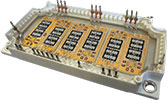
IGBTs or super-junction MOSFETs, in combination with SiC diodes, have already become the norm in various applications, such as solar, chargers and power supplies. This combination – a fast silicon-based switch matched with a SiC diode – is often termed a ‘hybrid’ solution. In recent years, Infineon has manufactured several million hybrid modules and has seen them installed in various customer products. In fact, the world’s first hybrid module was developed more than 10 years ago based on Infineon’s EconoPACK package platform.
Certain application segments will always be early adopters of any new technology. Depending on the actual system value, others will follow when cost/performance of the new technology is attractive enough to make a switch to a new, higher-tech solution.
Following the already well established designs using SiC diodes in high-end power supplies, Infineon has identified solar inverters and boost circuits as the areas most likely to benefit the most from this new technology. Behind this the associated market segments of uninterruptible power supplies (UPS) and chargers are likely to follow.
It is expected that more traditional segments like motor drives, traction, and on a long timescale, automotive applications, will in the future become very interested in a large scale changeover to this new semiconductor technology.
In the past, energy efficiency was the key design and marketing capability for success with solar converters. SiC diodes, for example used as part of the booster circuit, were the best solution to achieve efficiency levels of 98% or better.
Today, the ongoing major trend in solar designs is the increase of power density based on a reduction of switching losses, enabling smaller heatsinks and also allowing higher operating frequencies, which in turn enables smaller magnetics. SiC diodes have increasingly become a staple component in modern solar string inverter solutions as well as in micro-inverter applications.
Recently, Infineon’s SiC diode technology reached its 5th generation. SiC diodes made further progress by using options for die shrink in order to achieve a more attractive cost proposition. In addition, new technology features were implemented which will give additional customer benefits compared to the previous generations, for example lower forward voltage drop, resulting in lower conduction losses, increased surge current capability and an enhancement of the breakdown behaviour. Hybrid solutions are a standard part of today’s solar inverters all around the world. Infineon has become a trusted partner of this technology after more than 15 years availability, a proven track record and dependable high-volume production.
With its integrated manufacturing concept – manufacturing of SiC chips utilising the same production lines as the high-volume silicon power chips – Infineon is able to guarantee reliability and process stability at the same level as its silicon products. In addition, this integrated concept delivers volume flexibility, a key factor in order to handle needed emerging technologies in fast-moving market segments.
Based on a deep system understanding and a clear focus on cost performance, it has been possible to successfully define products by forming optimised combinations between silicon and silicon carbide based semiconductors. This move, away from a purely semiconductor technology driven definition of products, towards solutions tailor made for the targeted system, is seen as a key element for the success of SiC in the future.
Based on its experience with the diode technology, Infineon will follow a similar rollout of SiC transistors in the next few years. This is an important next step in order to move SiC much closer to the level of a mainstream technology.
In recent times, intensive studies have been carried out mainly in order to understand the system benefits of SiC. The increase of switching frequency for a converter using unipolar
SiC transistors can result in dramatically reduced volume and weight of the magnetic components. From an analysis carried out by Infineon, a converter built on SiC devices is a third of the size and a quarter of the weight compared to a current silicon-based reference solution.
Thanks to the significant reduction in volume and weight, system costs can also be reduced by more than 20%.
Over the next few years, SiC solutions will expand into other application fields such as industrial or traction drives. The reasons for this are the market forces pushing for loss reduction – not only for the sake of improved efficiency but also for smaller packages – resulting from reduced heatsink requirements. As shown in Figure 2, SiC is already being used for high-end and niche solutions. Today’s designs use these benefits to reduce system cost in specific application areas.
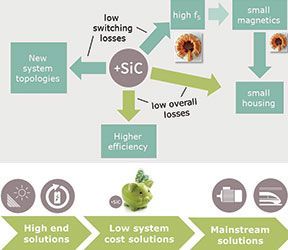
In the future, more and more applications will benefit from the overall loss reduction made possible by implementing SiC solutions. In this regard, the next major step forward will be the introduction of SiC switches.
Differences between Si and SiC
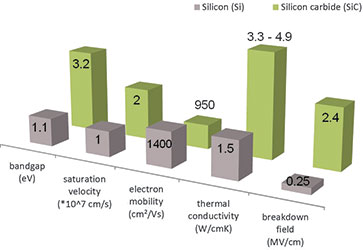
To understand the differences between Si and SiC solutions, it has to be made clear that silicon carbide devices belong to the so-called wide bandgap semiconductors. A comparison of Si vs. SiC material properties is shown in Figure 3. The voltage range for fast and unipolar Schottky diodes, as well as field effect based SiC switches (MOSFET, JFET), can be extended to over 1000 V. This is possible because of inherent properties of the SiC material:
• The low leakage current in high-voltage Schottky diodes is possible because of the metal-semiconductor barrier which is two times higher than in Si Schottky diodes.
• The very attractive, specific on-resistance of unipolar transistors compared to Si is achieved because of the breakdown field strength which is approximately 10 times higher.
Figure 4 shows the minimum specific on-resistance of different semiconductors versus the desired blocking voltage (only the drift region is used here, any substrate contribution to the resistivity is neglected). The end points of each line symbolise the usable voltage range of the specific semiconductor in a unipolar configuration (excluding super-junction MOSFETS).
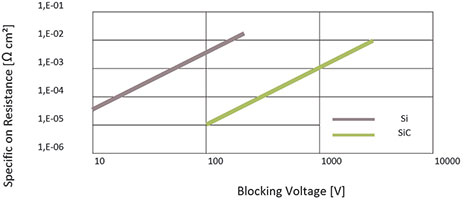
SiC transistors are about to become an attractive alternative to today’s established IGBT technologies in industrial power electronics. The dedicated material properties of SiC enable the design of minority carrier-free unipolar devices instead of the charge modulated IGBT devices at high blocking voltages. This is based mainly on the high critical field which is provided by the wide bandgap.
The loss restrictions of IGBTs are caused by the dynamics of minority carriers. In MOSFETs those minority carriers are eliminated. As an example, extremely high dv/dt slopes in the range above 100 kV/μs have been measured for SiC MOSFETs.
In the beginning, the superior dynamic performance of SiC based transistors compared to IGBTs in the area of 1200 V and higher was seen as the most important advantage. However, recent results indicate a significant future potential in the IGBT technologies, as shown by Infineon’s TRENCHSTOP 5 technology.
Taking the long term view, however, the fundamental differences between the IGBT and the unipolar SiC switch will increasingly attract attention. The two major differences are the linear, threshold free I-V curve of the output characteristic; and the ability to integrate a body diode with the option of synchronous rectification. Based on these properties, the device offers threshold-free conduction behaviour in synchronous rectification mode. In addition, the number of necessary components is reduced by half. This leads to a significant reduction of the required power module footprint.
Loss reduction
At a system level, the feature of threshold-free conduction behaviour offers a significant potential for loss reduction. Many systems are operated for a large portion of their lives under partial load conditions and conduction losses are considerably lower compared to the competing standard IGBT technologies. Even at very low frequencies of less than 5 kHz and unchanged dv/dt slopes, it can be seen that a threshold-free switch with integrated body diode, in synchronous rectification mode, offers a potential of 50% total loss reduction compared to a commercial IGBT solution available today. The comparison in losses can be seen in Figure 5.
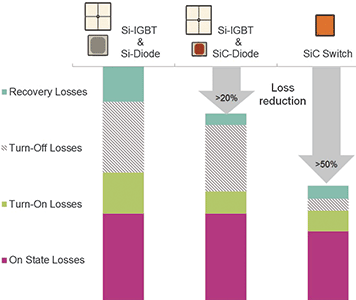
Obviously, the loss reduction will be even higher in applications where there is no dv/dt limitation and at much higher switching frequencies. This is common in DC-DC boost or buck/boost topologies, providing the benefit of smaller, lighter and lower-cost magnetic components. Various studies have already proven that, even with more expensive power switches, the bill of materials can be reduced over a wide spectrum of applications. This number of applications will increase over the mid-term time frame based on the anticipated cost reduction over time for SiC based components.
The objective for a SiC transistor design is primarily to achieve the lowest area specific on-resistance. This is quite logical, since this parameter defines cost and also indirectly the remaining dynamic losses which are caused by chip capacitance values. The smaller the die for a given resistance, the lower the capacitance values.
Battling the drawbacks
High defect density is reflected in various idiosyncrasies of SiC MOS based devices. One example is a weak transconductance in comparison to silicon-based power MOSFETs, combined with a low threshold voltage.
Another effect is a non-physical temperature behaviour of the on-resistance. Physics indicates that the R(on) will typically increase at higher temperatures. Components available today sometimes show zero or even negative temperature dependence. This is due to the fact that the defect related resistance contribution has a negative temperature coefficient and thus, a different temperature behaviuor is observed.
The less the R(on) increases with temperature, the higher the impact of channel defects on the device performance. A drop of the defect related resistance contribution can be effectively achieved only by increasing the applied field across the oxide in on-state above values that are usually used in silicon based MOS power devices. Since high fields across the oxide in the on-state can potentially accelerate the blocking capability wear out, it can be deemed a long term reliability risk.
The overall goal is to combine the low R(on) potential offered by SiC with an operational mode where the part remains inside the well researched safe oxide field conditions. In the on-state this can be achieved by moving away from the planar surface, with its high defect density, towards other, more favourable surface orientations. MOS channels on the so-called ‘a’ face of SiC, offer a factor of at least 10 times lower defect densities. For this reason, one possible approach is to use a trench based structure, similar to many modern silicon power devices.
Besides the low channel resistance, cell density in such structures can be naturally higher than in planar structures, ending up in more effective material utilisation. Additionally, this would lead to a lower area specific on-resistance. However, in trench-based components the field stress on the oxide at trench corners is a critical issue and, especially in SiC, this can be a show stopping argument. This semiconductor chip is proposed to use about ten times higher electric field compared to Si solutions. There are various possibilities in place to realise an effective shielding of the critical areas, e.g. by deep pn elements. In contrast to the on-state dilemma in the DMOS, the off-state challenge can be addressed by an ingenious design.
Bright future for SiC
A powerful SiC switch offering proven and established ruggedness similar to silicon based components will have a bright future in power electronics applications – even if new challenges are attached to the new technology. In the beginning, there will have to be additional efforts to utilise the technology in the best and most effective way. Challenges include EMI topics arising from faster switching or cooling challenges caused by much higher power densities. The latter are inevitable and combined with the chip shrink, which will not be offset by the expected loss reduction.
To enable faster penetration of SiC transistor technology, it is beneficial to address these valid concerns. In this regard, Infineon is dedicated to partnering with customers to minimise any design and implementation processes made necessary by the new technology.
It is axiomatic that new semiconductor technologies will be the key enabler to meet the increasing demands for improved power density and efficiency of applications based on power semiconductors. However, the replacement of silicon-based components will not be a matter of the coming years.
Instead, wide bandgap technologies are able to complement silicon based solutions, especially where they can open up new application niches which cannot be addressed by current technologies. SiC is seen here as the major innovation for industrial power applications targeted at components with blocking voltages above 100 V and power ratings up to several hundreds of kilowatts, as shown in Figure 6.
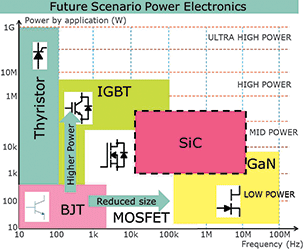
After the successful market introduction of SiC diode technologies, SiC based transistors will be the next major step. By now much higher levels of performance are expected from the wide bandgap material. For a fast market acceptance, ruggedness and system oriented product features are key elements.
For more information contact Davis Moodley, Infineon Technologies, +27 (0)11 706 6099, [email protected], www.infineon.com

© Technews Publishing (Pty) Ltd | All Rights Reserved